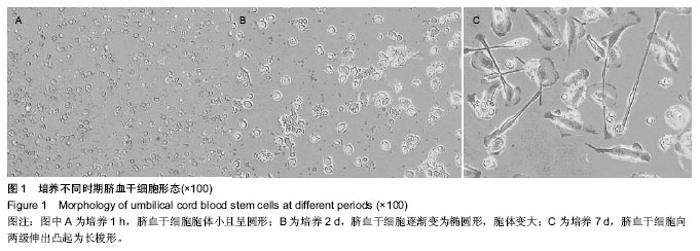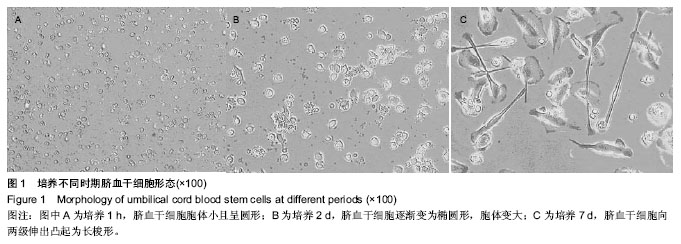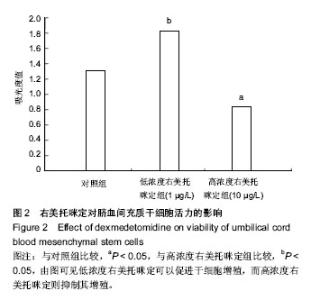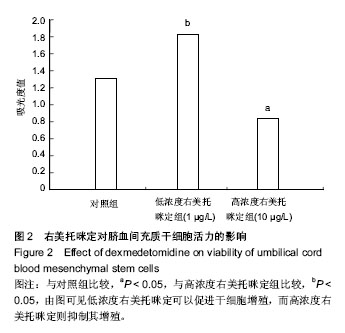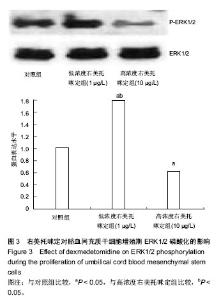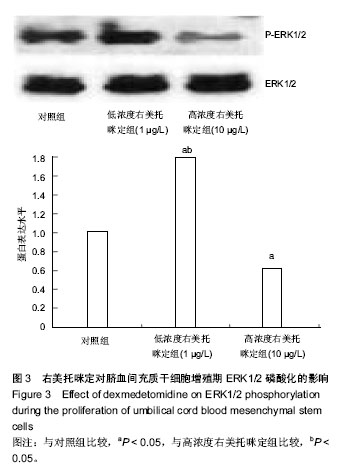Chinese Journal of Tissue Engineering Research ›› 2014, Vol. 18 ›› Issue (50): 8088-8092.
Previous Articles Next Articles
Effect of dexmedetomidine on neuronal differentiation of umbilical cord blood mesenchymal stem cells
Fan Zhi-gang, Qiao Lei
- Henan Medical College, Zhengzhou 451191, Henan Province, China
-
Online:2014-12-03Published:2014-12-03
CLC Number:
Cite this article
Fan Zhi-gang, Qiao Lei. Effect of dexmedetomidine on neuronal differentiation of umbilical cord blood mesenchymal stem cells[J]. Chinese Journal of Tissue Engineering Research, 2014, 18(50): 8088-8092.
share this article
Add to citation manager EndNote|Reference Manager|ProCite|BibTeX|RefWorks
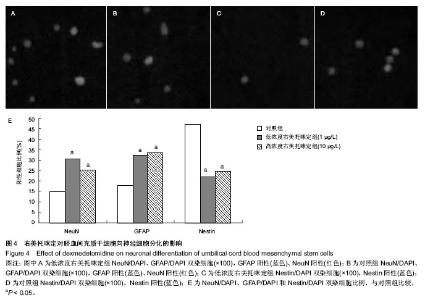
2.2 流式细胞仪检测结果 CD34、CD45的阳性率不足10%,CD19和CD86阳性率少于10%,CD90、CD105阳性率高于70%,主要组织相容性复合体HLA-ABC的阳性率为90%以上,HLA-DR阳性率低于5%,结果显示所培养细胞符合间充质干细胞表面分子标记特征。 2.3 右美托咪定对脐血间充质干细胞活力的影响 MTT法检测结果表明,低浓度右美托咪定组吸光值较对照组显著增高(P < 0.05),高浓度右美托咪定组吸光值则较对照组明显降低(P < 0.05),高浓度右美托咪定组吸光值较低浓度右美托咪定组也明显降低(P < 0.05),说明低浓度右美托咪定可以促进干细胞增殖,而高浓度右美托咪定则抑制其增殖,见图2。 2.4 右美托咪定对脐血间充质干细胞增殖期ERK1/2磷酸化的影响 与对照组相比,低浓度右美托咪定组脐血间充质干细胞ERK1/2磷酸化水平明显增加(P < 0.05),而高浓度右美托咪定组脐血间充质干细胞ERK1/2磷酸化水平则较明显下降(P < 0.05),高浓度右美托咪定组较低浓度右美托咪定组也明显下降(P < 0.05),说明低浓度右美托咪定促进干细胞增殖可能是通过提高ERK1/2磷酸化水平实现的, 而高浓度右美托咪定抑制其增殖是降低了ERK1/2磷酸化水平,见图3。2.5 右美托咪定对脐血间充质干细胞向神经细胞分化的影响 通过免疫荧光计数可见,对于NeuN阳性(神经元细胞)、GFAP阳性(胶质细胞)比例,低浓度右美托咪定组和高浓度右美托咪定组均较对照组明显增加(P < 0.05),见图4A,B;低、高浓度右美托咪定组间差异无显著性意义(P > 0.05)。对于Nestin阳性(神经干细胞)比例,低浓度右美托咪定组和高浓度右美托咪定组均较对照组明显降低(P < 0.05),见图4C,D;低、高浓度右美托咪定组间差异无显著性意义(P > 0.05),说明高、低浓度右美托咪定都可促进脐血干细胞向神经细胞的分化,且差异无显著性意义,见图4E。"
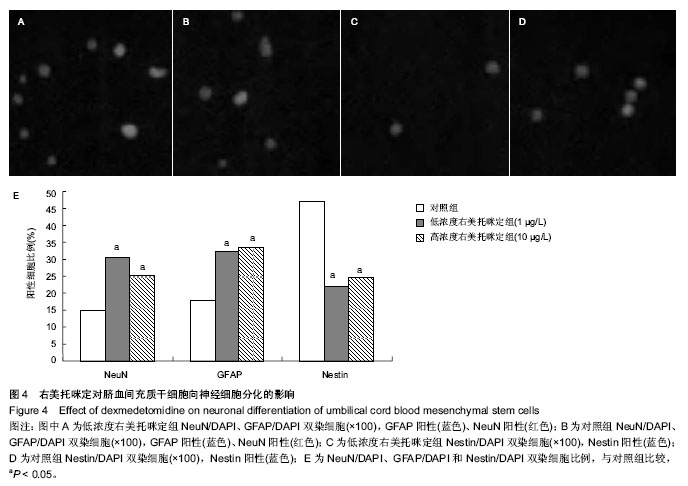
| [1] Sun L, Guo R, Sun L.Dexmedetomidine for preventing sevoflurane-related emergence agitation in children: a meta-analysis of randomized controlled trials.Acta Anaesthesiol Scand. 2014;58(6):642-650. [2] Kachalia A,Kachalia K,Nagalli S,et al.Analysis of safety and eficacy of dexmedetomidine as adjunctive therapy for alcohol with drawal in ICU.Chest.2014;145(3 Supp1):207A. [3] Engelhard K, Werner C, Eberspächer E,et al.The effect of the alpha 2-agonist dexmedetomidine and the N-methyl-D- aspartate antagonist S(+)-ketamine on the expression of apoptosis-regulating proteins after incomplete cerebral ischemia and reperfusion in rats.Anesth Analg. 2003;96(2): 524-531. [4] Wang X, Ji J, Fen L, et al.Effects of dexmedetomidine on cerebral blood flow in critically ill patients with or without traumatic brain injury: a prospective controlled trial.Brain Inj. 2013;27(13-14):1617-1622. [5] 韩缪,张晴晴,费远晖,等.鞘内注射右美托咪定对小鼠催眠和学习记忆的影响[J].徐州医学院学报,2013,33(9):577-579. [6] 柏平,吴修建,闫东.右美托咪啶与咪达唑仑对幼鼠神经细胞损伤及学习记忆功能的影响[J].重庆医学,2013,42(25):2966-2968. [7] 赵俊暕,陈乃耀,石峻,等.人脐血间充质干细胞移植对创伤性脑损伤大鼠VEGF分泌及血管新生的影响[J].中国神经免疫学和神经病学杂志,2013,20(4):267-273. [8] 郑志娟,庄文欣,付文玉.人脐带间充质干细胞的研究进展[J].解剖科学进展,2008,14(1):100-104. [9] 田晓宁.脐血干细胞的特性及其临床应用[J].中国组织工程研究与临床康复,2009,13(36):7197-7200. [10] Bjugstad KB, Teng YD, Redmond DE Jr,et al.Human neural stem cells migrate along the nigrostriatal pathway in a primate model of Parkinson's disease.Exp Neurol. 2008;211(2): 362-369. [11] Sanders RD, Xu J, Shu Y,et al.Dexmedetomidine attenuates isoflurane-induced neurocognitive impairment in neonatal rats.Anesthesiology. 2009;110(5):1077-1085. [12] Sanders RD, Sun P, Patel S,et al.Dexmedetomidine provides cortical neuroprotection: impact on anaesthetic-induced neuroapoptosis in the rat developing brain.Acta Anaesthesiol Scand. 2010;54(6):710-716. [13] Pucilowska J, Puzerey PA, Karlo JC,et al.Disrupted ERK signaling during cortical development leads to abnormal progenitor proliferation, neuronal and network excitability and behavior, modeling human neuro-cardio-facial-cutaneous and related syndromes.J Neurosci. 2012;32(25):8663-8677. [14] Bjugstad KB, Teng YD, Redmond DE Jr,et al.Human neural stem cells migrate along the nigrostriatal pathway in a primate model of Parkinson's disease.Exp Neurol. 2008;211(2): 362-369. [15] Sung MA, Jung HJ, Lee JW, et al. Human umbilical cord blood-derived mesenchymal stem cells promote regeneration of crush-injured rat sciatic nerves. Neural Regen Res. 2012; 7(26): 2018-2027. [16] 王蒙,杨媛,史春梦,等.人脐血源性MSCs成骨诱导分化后对DCs的免疫抑制研究[J].免疫学杂志,2012,28(11):959-963. [17] 孙艳,段芳龄,陈香宇,等.体外诱导人脐血间充质干细胞向肝细胞样细胞分化的研究[J].胃肠病学和肝病学杂志,2004,13(3): 239-243. [18] 李恒,李晓红,毕建芬,等.全反式维甲酸促人脐血多能干细胞向多巴胺能神经元分化[J].山东大学学报:医学版,2012,50(6):92-96. [19] Pucilowska J, Puzerey PA, Karlo JC,et al.Disrupted ERK signaling during cortical development leads to abnormal progenitor proliferation, neuronal and network excitability and behavior, modeling human neuro-cardio-facial-cutaneous and related syndromes.J Neurosci. 2012;32(25):8663-8677. [20] Herold S, Jagasia R, Merz K,et al.CREB signalling regulates early survival, neuronal gene expression and morphological development in adult subventricular zone neurogenesis.Mol Cell Neurosci. 2011;46(1):79-88. [21] Bhana N, Goa KL, McClellan KJ.Dexmedetomidine.Drugs. 2000;59(2):263-268. [22] Bekker A, Sturaitis M, Bloom M,et al.The effect of dexmedetomidine on perioperative hemodynamics in patients undergoing craniotomy.Anesth Analg. 2008;107(4): 1340- 1347. [23] Takamatsu I, Iwase A, Ozaki M,et al.Dexmedetomidine reduces long-term potentiation in mouse hippocampus. Anesthesiology. 2008;108(1):94-102. [24] Sanders RD, Sun P, Patel S,et al.Dexmedetomidine provides cortical neuroprotection: impact on anaesthetic-induced neuroapoptosis in the rat developing brain.Acta Anaesthesiol Scand. 2010;54(6):710-716. [25] Herold S, Jagasia R, Merz K,et al.CREB signalling regulates early survival, neuronal gene expression and morphological development in adult subventricular zone neurogenesis.Mol Cell Neurosci. 2011;46(1):79-88. [26] Wang X, Ji J, Fen L, et al.Effects of dexmedetomidine on cerebral blood flow in critically ill patients with or without traumatic brain injury: a prospective controlled trial.Brain Inj. 2013;27(13-14):1617-1622. [27] 杜婷.肾上腺素能受体激动剂引起星形胶质细胞和小鼠脑内ERK1/2磷酸化的信号传导途径[D].沈阳:中国医科大学,2011. [28] Diaz NL, Waters CH.Current strategies in the treatment of Parkinson's disease and a personalized approach to management.Expert Rev Neurother. 2009;9(12):1781-1789. [29] Pucilowska J, Puzerey PA, Karlo JC,et al.Disrupted ERK signaling during cortical development leads to abnormal progenitor proliferation, neuronal and network excitability and behavior, modeling human neuro-cardio-facial-cutaneous and related syndromes.J Neurosci. 2012;32(25):8663-8677. [30] Kögler G, Callejas J, Sorg RV, et al.The effect of different thawing methods, growth factor combinations and media on the ex vivo expansion of umbilical cord blood primitive and committed progenitors.Bone Marrow Transplant. 1998;21(3): 233-241. |
| [1] | Lin Qingfan, Xie Yixin, Chen Wanqing, Ye Zhenzhong, Chen Youfang. Human placenta-derived mesenchymal stem cell conditioned medium can upregulate BeWo cell viability and zonula occludens expression under hypoxia [J]. Chinese Journal of Tissue Engineering Research, 2021, 25(在线): 4970-4975. |
| [2] | Pu Rui, Chen Ziyang, Yuan Lingyan. Characteristics and effects of exosomes from different cell sources in cardioprotection [J]. Chinese Journal of Tissue Engineering Research, 2021, 25(在线): 1-. |
| [3] | Hou Jingying, Yu Menglei, Guo Tianzhu, Long Huibao, Wu Hao. Hypoxia preconditioning promotes bone marrow mesenchymal stem cells survival and vascularization through the activation of HIF-1α/MALAT1/VEGFA pathway [J]. Chinese Journal of Tissue Engineering Research, 2021, 25(7): 985-990. |
| [4] | Shi Yangyang, Qin Yingfei, Wu Fuling, He Xiao, Zhang Xuejing. Pretreatment of placental mesenchymal stem cells to prevent bronchiolitis in mice [J]. Chinese Journal of Tissue Engineering Research, 2021, 25(7): 991-995. |
| [5] | Liang Xueqi, Guo Lijiao, Chen Hejie, Wu Jie, Sun Yaqi, Xing Zhikun, Zou Hailiang, Chen Xueling, Wu Xiangwei. Alveolar echinococcosis protoscolices inhibits the differentiation of bone marrow mesenchymal stem cells into fibroblasts [J]. Chinese Journal of Tissue Engineering Research, 2021, 25(7): 996-1001. |
| [6] | Fan Quanbao, Luo Huina, Wang Bingyun, Chen Shengfeng, Cui Lianxu, Jiang Wenkang, Zhao Mingming, Wang Jingjing, Luo Dongzhang, Chen Zhisheng, Bai Yinshan, Liu Canying, Zhang Hui. Biological characteristics of canine adipose-derived mesenchymal stem cells cultured in hypoxia [J]. Chinese Journal of Tissue Engineering Research, 2021, 25(7): 1002-1007. |
| [7] | Geng Yao, Yin Zhiliang, Li Xingping, Xiao Dongqin, Hou Weiguang. Role of hsa-miRNA-223-3p in regulating osteogenic differentiation of human bone marrow mesenchymal stem cells [J]. Chinese Journal of Tissue Engineering Research, 2021, 25(7): 1008-1013. |
| [8] | Lun Zhigang, Jin Jing, Wang Tianyan, Li Aimin. Effect of peroxiredoxin 6 on proliferation and differentiation of bone marrow mesenchymal stem cells into neural lineage in vitro [J]. Chinese Journal of Tissue Engineering Research, 2021, 25(7): 1014-1018. |
| [9] | Zhu Xuefen, Huang Cheng, Ding Jian, Dai Yongping, Liu Yuanbing, Le Lixiang, Wang Liangliang, Yang Jiandong. Mechanism of bone marrow mesenchymal stem cells differentiation into functional neurons induced by glial cell line derived neurotrophic factor [J]. Chinese Journal of Tissue Engineering Research, 2021, 25(7): 1019-1025. |
| [10] | Duan Liyun, Cao Xiaocang. Human placenta mesenchymal stem cells-derived extracellular vesicles regulate collagen deposition in intestinal mucosa of mice with colitis [J]. Chinese Journal of Tissue Engineering Research, 2021, 25(7): 1026-1031. |
| [11] | Pei Lili, Sun Guicai, Wang Di. Salvianolic acid B inhibits oxidative damage of bone marrow mesenchymal stem cells and promotes differentiation into cardiomyocytes [J]. Chinese Journal of Tissue Engineering Research, 2021, 25(7): 1032-1036. |
| [12] | Li Cai, Zhao Ting, Tan Ge, Zheng Yulin, Zhang Ruonan, Wu Yan, Tang Junming. Platelet-derived growth factor-BB promotes proliferation, differentiation and migration of skeletal muscle myoblast [J]. Chinese Journal of Tissue Engineering Research, 2021, 25(7): 1050-1055. |
| [13] | Liu Cong, Liu Su. Molecular mechanism of miR-17-5p regulation of hypoxia inducible factor-1α mediated adipocyte differentiation and angiogenesis [J]. Chinese Journal of Tissue Engineering Research, 2021, 25(7): 1069-1074. |
| [14] | Wang Xianyao, Guan Yalin, Liu Zhongshan. Strategies for improving the therapeutic efficacy of mesenchymal stem cells in the treatment of nonhealing wounds [J]. Chinese Journal of Tissue Engineering Research, 2021, 25(7): 1081-1087. |
| [15] | Wang Shiqi, Zhang Jinsheng. Effects of Chinese medicine on proliferation, differentiation and aging of bone marrow mesenchymal stem cells regulating ischemia-hypoxia microenvironment [J]. Chinese Journal of Tissue Engineering Research, 2021, 25(7): 1129-1134. |
| Viewed | ||||||
|
Full text |
|
|||||
|
Abstract |
|
|||||
